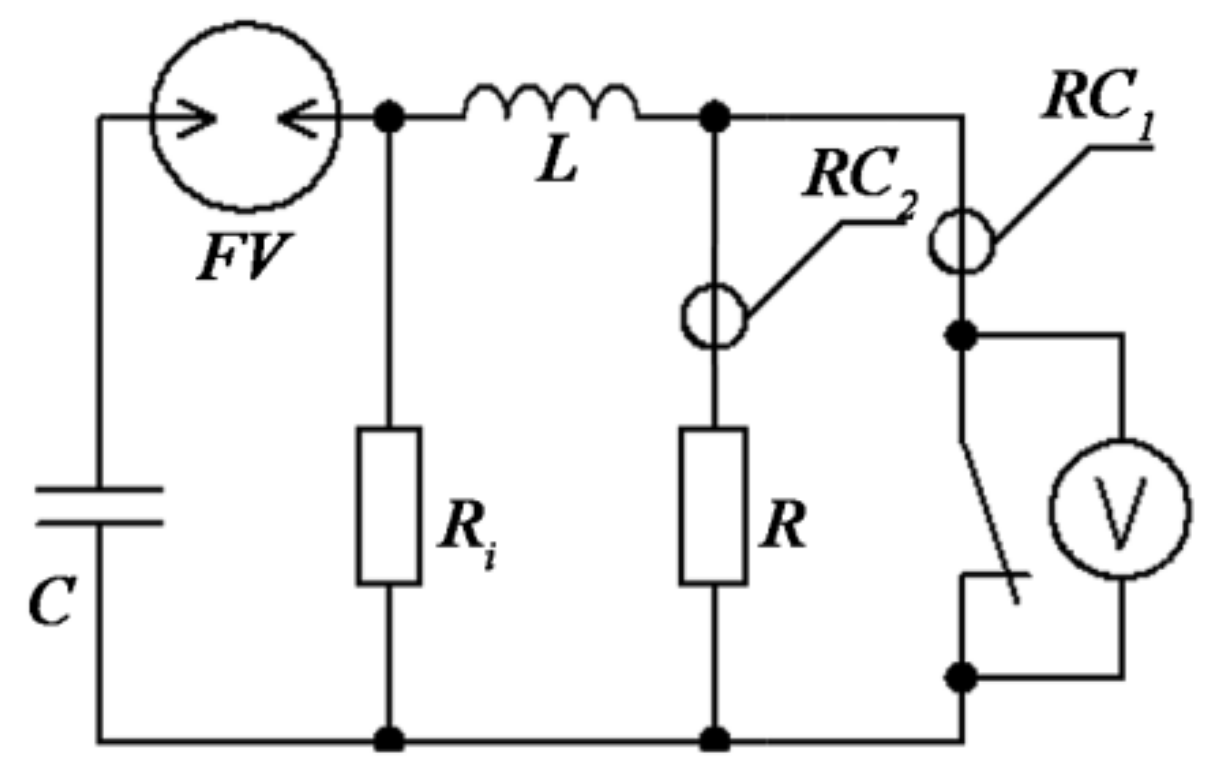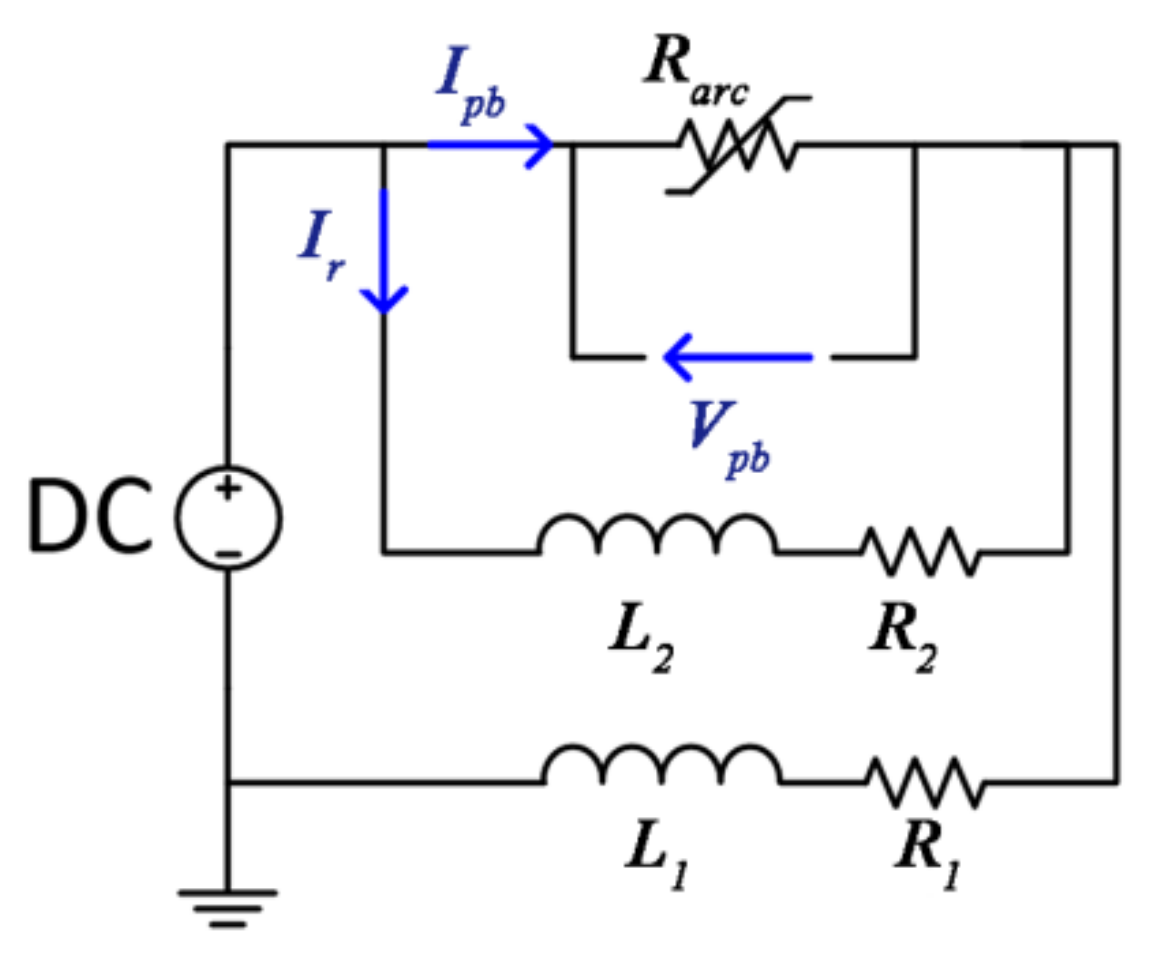Application of an Improved Mayr-Type Arc Model in Pyro-Breakers Utilized in Superconducting Fusion Facilities
Abstract
:1. Introduction
1.1. Motivation and Incitement
1.2. Literature Review
1.3. Paper Organization and Contribution
2. Arc Modeling for Pyro-Breaker
2.1. The Commutation Section in the Pyro-Breaker
2.2. The Schavemaker Black-Box Arc Model
3. Simulation and Experiment
3.1. Parameter Fitting
3.2. Simulation and Experiment
3.3. Discussion
4. Conclusions
Author Contributions
Funding
Institutional Review Board Statement
Informed Consent Statement
Data Availability Statement
Acknowledgments
Conflicts of Interest
| Nomenclature of the Variables | |
| g | arc conductance |
| t | time |
| u | arc voltage |
| i | arc current |
| τ | time constant |
| P0 | cooling power |
| E0 | reference arc voltage |
| P1 | cooling constant |
| Ipb | current in the pyro-breaker branch |
| Ir | current in the discharge resistor branch |
| Vpb | voltage across the pyro-breaker |
| R2 | fit goodness |
| Abbreviations | |
| DC | direct current |
| AC | alternating current |
| QPS | Quench Protection System |
| ITER | International Thermonuclear Experimental Reactor |
| CFETR | China Fusion Engineering Test Reactor |
| PSCAD | Power Systems Computer Aided Design |
| CS | Commutation Section |
References
- Park, J.S.; Choi, J.H.; Gu, B.G.; Jung, I.G. Feasibility study of DC electrical distribution system. In Proceedings of the 8th International Conference on Power Electronics—ECCE Asia, Jeju, Korea, 29 May 2011–2 June 2011; pp. 2935–2938. [Google Scholar] [CrossRef]
- Li, H.; Xiang, B.; Song, W.; Geng, Y.; Liu, Z.; Wang, J.; Pei, X.; Tu, Y. Effect of Arc Chute on DC Current Interruption by Liquid Nitrogen in HTS Electrical System of Distributed Propulsion Aircraft. IEEE Trans. Appl. Supercond. 2021, 31, 1–5. [Google Scholar] [CrossRef]
- Yazdani-Asrami, M.; Zhang, M.; Yuan, W. Challenges for developing high temperature superconducting ring magnets for rotating electric machine applications in future electric aircrafts. J. Magn. Magn. Mater. 2021, 522, 1–3. [Google Scholar] [CrossRef]
- Niewind, J.; Hemdan, N.G.A.; Klosinski, C.; Bösche, D.; Kurrat, M.; Gerdinand, F.; Meisner, J.; Passon, S. Operation and protection of 380V DC distribution systems. In Proceedings of the 2017 IEEE Manchester PowerTech, Manchester, UK, 18–22 June 2017; pp. 1–6. [Google Scholar] [CrossRef]
- Fu, P.; Song, Z.Q.; Gao, G.; Tang, L.J.; Wu, Y.B.; Wang, L.S.; Liang, X.Y. Quench protection of the poloidal field superconducting coil system for the EAST tokamak. Nucl. Fusion. 2006, 46, S85. [Google Scholar] [CrossRef]
- Rummel, T.; Gaupp, O.; Lochner, G.; Sapper, J. Quench protection for the superconducting magnet system of WENDELSTEIN 7-X. IEEE Trans. Appl. Supercond. 2002, 12, 1382. [Google Scholar] [CrossRef]
- Barabaschi1, P.; Kamada, Y.; Shirai, H. Progress of the JT-60SA project. Nucl. Fusion. 2019, 59, 112005. [Google Scholar] [CrossRef]
- Song, I.; Choi, C.; Cho, M. Quench Protection System for the Superconducting Coil of the KSTAR Tokamak. IEEE Trans. Appl. Supercond. 2007, 17, 1–6. [Google Scholar] [CrossRef]
- Manzuk, M.; Avanesov, S.; Roshal, A.; Bestuzhev, K.; Nesterenko, A.; Volkov, S. The 70 kA pyrobreaker for ITER magnet back-up protection. Fusion Eng. Des. 2013, 88, 1537–1540. [Google Scholar] [CrossRef]
- Zhu, J.; Zhang, Y.; Dong, Y.; HL-2A Team. Characterization of plasma current quench during disruptions at HL-2A. Plasma Sci. Technol. 2017, 19, 055101. [Google Scholar] [CrossRef] [Green Version]
- Ren, Y.; Zhu, J.; Gao, X.; Shen, F.; Chen, S. Electromagnetic, mechanical and thermal performance analysis of the CFETR magnet system. Nucl. Fusion. 2015, 55, 093002. [Google Scholar] [CrossRef]
- Zheng, J.; Song, Y.; Liu, X.; Lu, K.; Qin, J. Overview of the Design Status of the Superconducting Magnet System of the CFETR. IEEE Trans. Appl. Supercond. 2018, 28, 4204305. [Google Scholar] [CrossRef]
- Song, Y.; Wu, S.; Li, J.; Wan, B.; Wan, Y.; Fu, P.; Ye, M.; Liu, S.; Gao, X. Concept design of CFETR Tokamak machine. In Proceedings of the 2013 IEEE 25th Symposium on Fusion Engineering (SOFE), San Francisco, CA, USA, 10–14 June 2013; pp. 1–6. [Google Scholar] [CrossRef]
- He, J.; Song, Z.; Tang, C.; Fu, P.; Zhang, J. Study of contact resistance in the design of a pyro-breaker applied in superconducting fusion facility. Plasma Sci. Technol. 2019, 21, 065602. [Google Scholar] [CrossRef]
- He, J.; Song, Z.; Tang, C.; Fu, P.; Ye, J. Designing of cooling water system for a pyro-breaker utilized in superconductive fusion facility. Fusion Eng. Des. 2019, 148, 111294. [Google Scholar] [CrossRef]
- Gammon, T.; Lee, W.; Zhang, Z.; Johnson, B.C. A Review of Commonly Used DC Arc Models. IEEE Trans. Ind. Appl. 2015, 51, 1398. [Google Scholar] [CrossRef]
- Khakpour, A.; Franke, S.; Uhrlandt, D.; Gorchakov, S.; Methling, R. Electrical Arc Model Based on Physical Parameters and Power Calculation. IEEE Trans. Plasma Sci. 2015, 43, 2721. [Google Scholar] [CrossRef]
- Rau, S.; Zhang, Z.; Lee, W. 3D magnetohydrodynamic modeling of DC arc in power system. In Proceedings of the 2016 IEEE/IAS 52nd Industrial and Commercial Power Systems Technical Conference (I&CPS), Detroit, MI, USA, 1–5 May 2016; pp. 1–7. [Google Scholar] [CrossRef]
- Cassie, A.M. Arc Rupture and Circuit Severity: A New Theory. In Proceedings of the Conférence Internationale des Grands Réseaux Électriques à Haute Tension (CIGRE Report), Paris, France, 29 June–8 July 1939; Volume 102, pp. 1–14. [Google Scholar]
- Mayr, O. Beitrage zur Theorie des Statischen und des Dynamischen Lichtbogens. Arch. Elektr. 1943, 37, 588–608. [Google Scholar] [CrossRef]
- Wu, X.; Li, Z.; Tian, Y.; Mao, W.; Xie, X. Investigate on the simulation of black-box arc model. In Proceedings of the 2011 1st International Conference on Electric Power Equipment—Switching Technology, Xi’an, China, 23–27 October 2011; pp. 629–636. [Google Scholar] [CrossRef]
- Ahmethodzic, A.; Kapetanovic, M.; Sokolija, K.; Smeets, R.P.P.; Kertesz, V. Linking a physical arc model with a black box arc model and verification. IEEE Trans. Dielectr. Electr. Insul. 2011, 18, 1029. [Google Scholar] [CrossRef]
- Schavemaker, P.H.; Slui, L. An improved Mayr-type arc model based on current-zero measurements [circuit breakers]. IEEE Trans. Power Deliv. 2000, 15, 580–584. [Google Scholar] [CrossRef]
- Guardado, J.L.; Maximov, S.G.; Melgoza, E.; Naredo, J.L.; Moreno, P. An improved arc model before current zero based on the combined Mayr and Cassie arc models. IEEE Trans. Power Deliv. 2005, 20, 138. [Google Scholar] [CrossRef]
- Gao, Y.; Wang, L.; Zhang, Y.; Zeng, K. Research on the Calculation Method for the Parameters of the Simplified Schavemaker AC Arc Model. In Proceedings of the 2018 Prognostics and System Health Management Conference (PHM-Chongqing), Chongqing, China, 26–28 October 2018; pp. 150–156. [Google Scholar] [CrossRef]
- Wang, D.; Liao, M.; Wang, R.; Li, T.; Qiu, J.; Li, J.; Duan, X.; Zou, J. Research on Vacuum Arc Commutation Characteristics of a Natural-Commutate Hybrid DC Circuit Breaker. Energies 2020, 13, 4823. [Google Scholar] [CrossRef]
- Hashemi, E.; Niayesh, K. DC Current Interruption Based on Vacuum Arc Impacted by Ultra-Fast Transverse Magnetic Field. Energies 2020, 13, 4644. [Google Scholar] [CrossRef]
- Najam, A.; Pieterse, P.; Uhrlandt, D. Electrical Modelling of Switching Arcs in a Low Voltage Relay at Low Currents. Energies 2020, 13, 6377. [Google Scholar] [CrossRef]
- Haupt, M. Untersuchung der Anwendungsmöglichkeiten von Lichtbogenzweipolmodellen zur Beschreibung des Thermischen Schaltverhaltens von SF6-Leistungsschaltem. PhD Thesis, RWTH Aachen University, Aachen, Germany, 12 February 1988. [Google Scholar]
- Strang, G. Linear Algebra and its Applications, 3rd ed.; Harcourt Brace Jovanovich Publishers: London, UK, 2010. [Google Scholar]
- Lim, S.; Khan, U.A.; Lee, J.; Lee, B.; Kim, K.; Gu, C. Simulation analysis of DC arc in circuit breaker applying with conventional black box arc model. In Proceedings of the 2015 3rd International Conference on Electric Power Equipment—Switching Technology (ICEPE-ST), Busan, Korea, 25–28 October 2015; pp. 332–336. [Google Scholar] [CrossRef]
- Park, K.; Lee, H.; Asif, M.; Lee, B.; Shin, T.; Gu, C. Assessment of various kinds of AC black-box arc models for DC circuit breaker. In Proceedings of the 2017 4th International Conference on Electric Power Equipment—Switching Technology (ICEPE-ST), Xi’an, China, 22–25 October 2017; pp. 465–469. [Google Scholar] [CrossRef]
- Yoon, K.H.; Spindle, H.E. A Study of the Dynamic Response of Arcs in Various Gases. Trans. Am. Inst. Electr. Eng. 1958, 77, 1634–1640. [Google Scholar] [CrossRef]
- Miklyaev, S. Pirobreaker RD-Test Report. JQ9M2X; Efremov Institute: St. Petersburg, Russia, 2013. [Google Scholar]
- Miklyaev, S. Test Report on Pirobreaker. MN7QZ6; Efremov Institute: St. Petersburg, Russia, 2014. [Google Scholar]
- Miklyaev, S. Report on Reliability Tests of the TF FDU Pirobreaker (Step 3). MU3Q8N; Efremov Institute: St. Petersburg, Russia, 2014. [Google Scholar]
- Miklyaev, S. Report on Reliability Tests of the TF FDU Pirobreaker (Step 4). RDTSHR; Efremov Institute: St. Petersburg, Russia, 2015. [Google Scholar]










| Electrical Components | L1 | R1 | L2 | R2 |
|---|---|---|---|---|
| Value | 5 mH | 2.5 mΩ | 5 μH | 133 mΩ |
| Electrical Components | L1 | R1 | L2 | R2 |
|---|---|---|---|---|
| Value | 5 mH | 2.5 mΩ | 20 μH | 50 mΩ |
Publisher’s Note: MDPI stays neutral with regard to jurisdictional claims in published maps and institutional affiliations. |
© 2021 by the authors. Licensee MDPI, Basel, Switzerland. This article is an open access article distributed under the terms and conditions of the Creative Commons Attribution (CC BY) license (https://creativecommons.org/licenses/by/4.0/).
Share and Cite
He, J.; Wang, K.; Li, J. Application of an Improved Mayr-Type Arc Model in Pyro-Breakers Utilized in Superconducting Fusion Facilities. Energies 2021, 14, 4383. https://doi.org/10.3390/en14144383
He J, Wang K, Li J. Application of an Improved Mayr-Type Arc Model in Pyro-Breakers Utilized in Superconducting Fusion Facilities. Energies. 2021; 14(14):4383. https://doi.org/10.3390/en14144383
Chicago/Turabian StyleHe, Jun, Ke Wang, and Jiangang Li. 2021. "Application of an Improved Mayr-Type Arc Model in Pyro-Breakers Utilized in Superconducting Fusion Facilities" Energies 14, no. 14: 4383. https://doi.org/10.3390/en14144383






